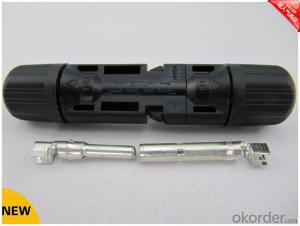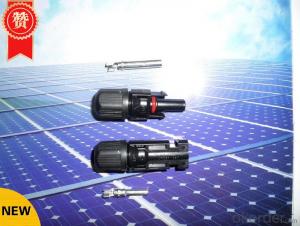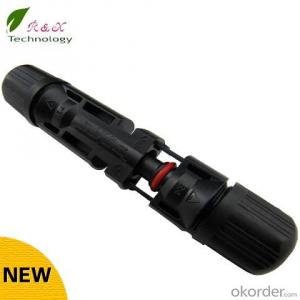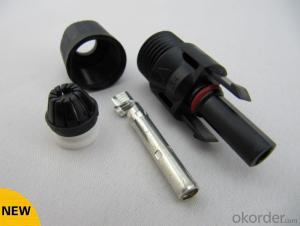MC4 Female/Male can contact 2.5/4/6mm2 Cable
- Loading Port:
- Guangzhou
- Payment Terms:
- TT OR LC
- Min Order Qty:
- 100 set
- Supply Capability:
- 100000 set/month
OKorder Service Pledge
OKorder Financial Service
You Might Also Like

Brief introductions of product:
Connector R4 System for photovoltaic adopts contact and insertion of reed with inner-knob type.It is used with male and famale points.pv junction box and cables made of elastomeric material and makes contact and isertion more certified by IEC61215 and TUV 2PFG1161.
Mainly parameters of product:
Rated voltage 1000V DC
Rated current 30A
Test volaage 6KV(50HZ,1min.)
Ambient temperaure range -40°C...+90°C
Upper limiting temperature 105°C
Degree of protection,mated IP67
unmated IP2X
Contact resistance of plug connectors 0.5m?
Safety class II
Contact system R4 Multilam
Type of termination Crimping
Contact material
Copper,tin plated
Locking system Snap-in(R4)
Cable type PV-F 1169 1*4mm2
1*6mm2
Design paper of product:

Way of product installation:

Quality inspection process:
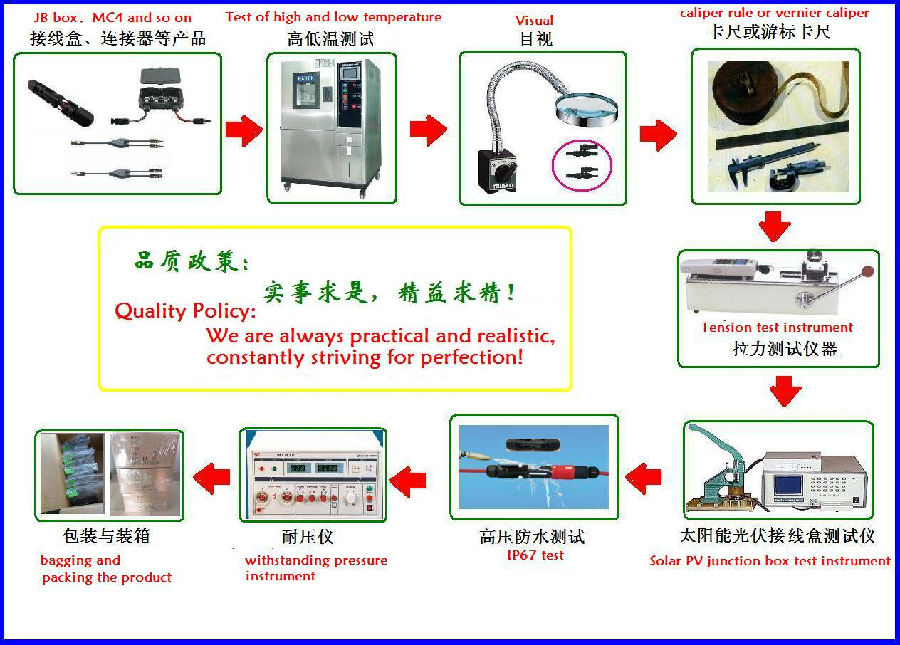
Application pictures of product:
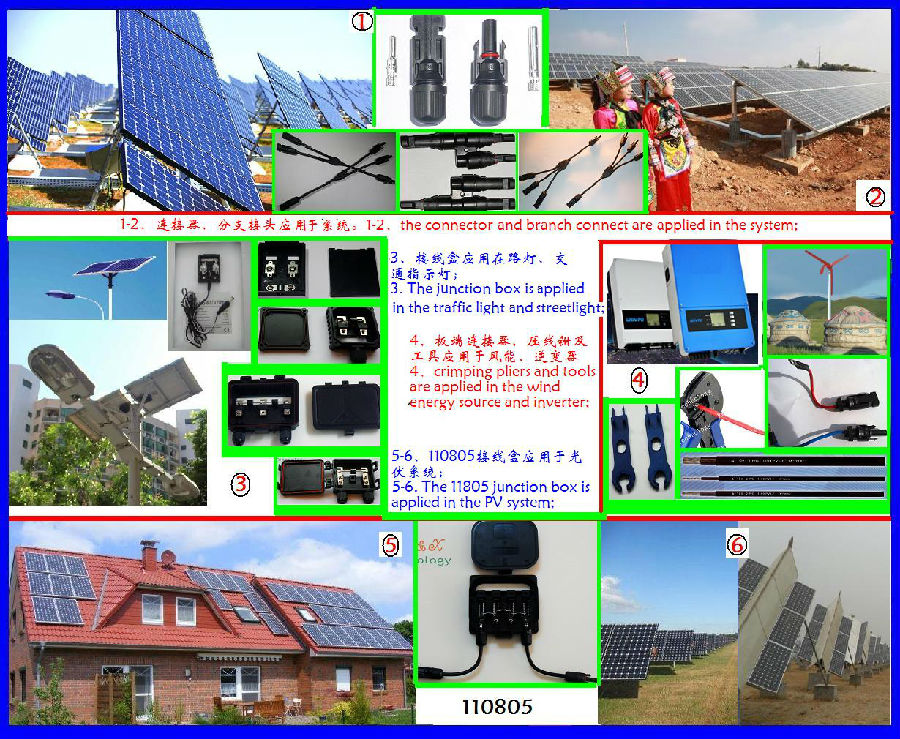
Machine equipment and production workshop:

Pictures of discussing in the exhibition:

True application picture of the project:

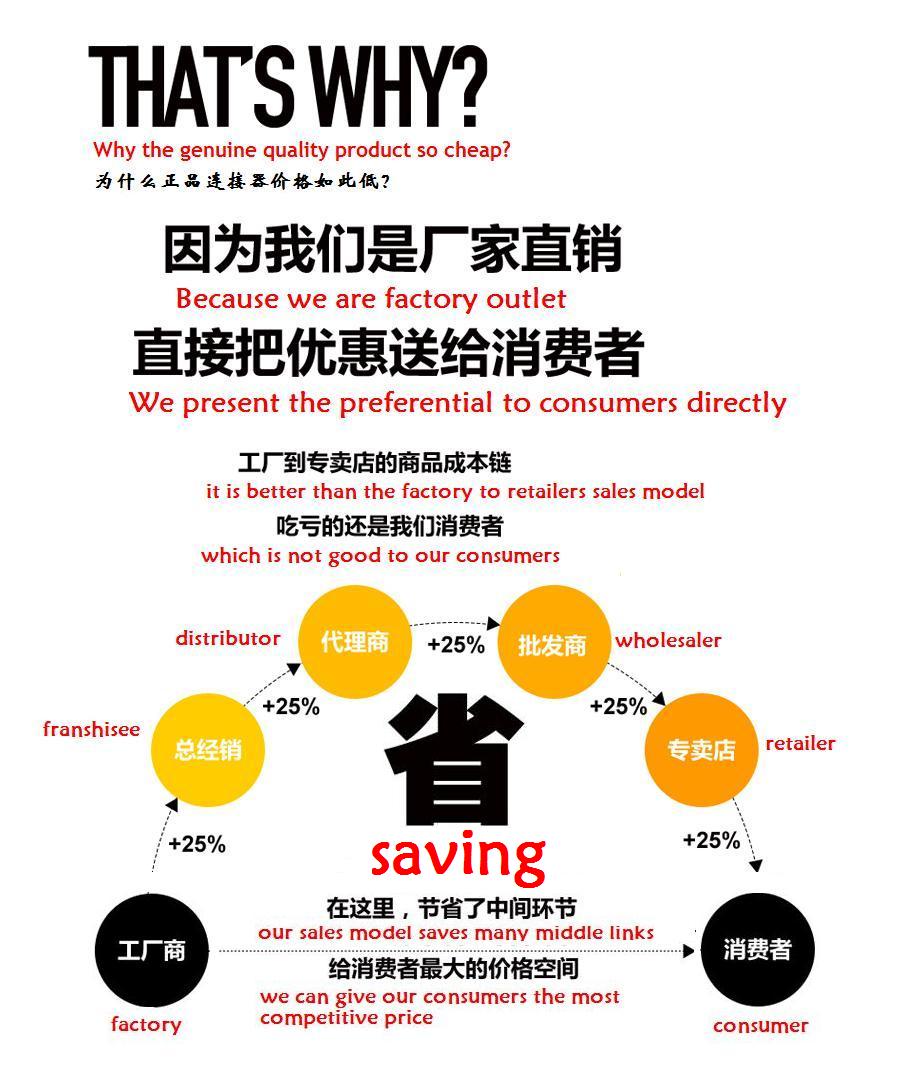
Multi-Contact Multi-Contact Multi-Contact Multi-Contact Multi-Contact Multi-Contact
- Q:Are there any risks of electrical grounding issues with solar energy systems?
- Yes, there can be risks of electrical grounding issues with solar energy systems. Improper grounding or lack of proper grounding can lead to electrical shocks, system malfunctions, and even fire hazards. It is crucial to ensure that solar panels, inverters, and other electrical components are correctly grounded to minimize these risks and ensure the safe and efficient operation of the system.
- Q:How can I find a reputable solar energy system installer?
- To find a reputable solar energy system installer, you can follow these steps: 1. Research and educate yourself: Begin by learning about solar energy systems, how they work, and the types of installations available. This will help you understand the basics and make informed decisions during the selection process. 2. Ask for recommendations: Reach out to friends, family, colleagues, or neighbors who have already installed solar systems. Inquire about their experience with the installer they hired, the quality of the work, and any potential issues or concerns they faced. Recommendations from trusted sources can be valuable in finding reputable installers. 3. Check credentials and certifications: Ensure that the installer you are considering has the necessary licenses, certifications, and insurance to carry out solar installations. Look for certifications from reputable organizations such as the North American Board of Certified Energy Practitioners (NABCEP) or the Solar Energy Industries Association (SEIA). 4. Research online reviews and ratings: Explore online review platforms, such as Google, Yelp, or Angie's List, to read customer reviews and ratings about different solar installers in your area. Pay attention to recurring positive or negative feedback and consider the overall reputation of the installer. 5. Obtain multiple quotes: Reach out to several solar installers and request detailed quotes for your specific project. Take note of the equipment they propose, warranties offered, pricing, and any additional services included. This will allow you to compare different installers and make an informed decision. 6. Ask for references and past projects: Request references from the installer to speak with previous customers about their experience. Inquire about the quality of work, timeliness, customer service, and any issues encountered. Additionally, ask the installer for examples of past projects they have completed to evaluate their workmanship and attention to detail. 7. Evaluate warranties and post-installation services: Inquire about the warranties provided by the installer for both the equipment and the installation work. A reputable installer will offer comprehensive warranties to ensure the longevity and performance of your solar system. Additionally, ask about any post-installation services they provide, such as maintenance, repairs, or monitoring. 8. Get multiple opinions: If you encounter any doubts or concerns during the selection process, don't hesitate to seek a second opinion from another reputable installer. This can help you gain further clarity and confidence in your decision. Remember, finding a reputable solar energy system installer is crucial for the long-term success and performance of your solar system. Take your time, do thorough research, and choose an installer that aligns with your needs, budget, and values.
- Q:Can solar energy be used for heating?
- Yes, solar energy can be used for heating. Solar thermal systems can capture the sun's energy and convert it into heat, which can be used for heating water, spaces, and even for industrial processes.
- Q:Can solar energy systems be connected to the existing power grid?
- Solar energy systems can indeed be linked to the current power grid, known as grid-tied or grid-connected solar systems. In this configuration, solar panels harness sunlight to generate electricity, which is then converted by inverters into usable AC power. This AC power is then integrated into the existing power grid, effectively supplementing the utility company's electricity supply. Grid-tied solar systems provide multiple advantages. Primarily, they allow homeowners and businesses to decrease their dependence on fossil fuel-based electricity and reduce their carbon footprint. Moreover, any surplus electricity generated by the solar panels can be returned to the grid, resulting in net metering or feed-in tariffs. In this scenario, the excess power is credited to the system owner by the utility company, leading to substantial cost savings or even potential revenue generation. Furthermore, grid-tied systems ensure a reliable and consistent supply of electricity. During periods when the solar panels are unable to generate sufficient power, such as at night or during cloudy weather, electricity can be acquired from the grid. Conversely, when the panels produce more electricity than is being utilized, the surplus is sent back to the grid, guaranteeing an uninterrupted and continuous power supply. It is important to acknowledge that the installation and connection of grid-tied solar systems may necessitate the approval and coordination of the local utility company, as well as adherence to pertinent regulations and safety standards. Nevertheless, the capability to connect solar energy systems to the existing power grid renders them a versatile and advantageous renewable energy solution.
- Q:What is the impact of snow cover on the performance of solar panels?
- The impact of snow cover on the performance of solar panels can vary depending on the severity and duration of the snowfall, as well as the design and tilt angle of the panels. When solar panels are covered in snow, they are unable to generate electricity as effectively. The snow blocks the sunlight from reaching the panel's surface, reducing the amount of energy that can be converted. This can lead to a decrease in the overall power output of the solar system during the snowy period. However, it is important to note that most solar panels are designed to have a tilt angle that allows for natural snow shedding. When the panels are installed at an angle, the snow can slide off more easily, exposing the surface and allowing sunlight to once again reach the photovoltaic cells. In regions with regular snowfall, it is common for solar panel installations to have a steeper tilt angle to facilitate snow removal. Additionally, some solar panels are equipped with anti-reflective coatings or self-cleaning features that can help reduce the impact of snow cover. These coatings or features can prevent snow from sticking to the surface, allowing for faster snow removal and improved performance. It is worth mentioning that snow cover can also have a positive impact on solar panels in certain cases. A thin layer of snow can act as an insulating layer, helping to retain heat and potentially increase the efficiency of the panels. However, this effect is generally minimal and limited to specific conditions. Overall, while snow cover can temporarily reduce the performance of solar panels, the impact can be mitigated through proper installation techniques and design considerations. In areas with regular snowfall, it is important to consider the tilt angle, anti-reflective coatings, and self-cleaning features to ensure optimal performance throughout the year.
- Q:Are solar energy systems affected by hail or other weather conditions?
- Yes, solar energy systems can be affected by hail or other extreme weather conditions. Hailstorms can potentially damage solar panels, reducing their efficiency or causing them to break. Additionally, severe weather conditions such as heavy rain, snow, or strong winds can affect solar energy production temporarily. However, modern solar panels are designed to withstand such weather events to a certain extent and are often tested for durability and impact resistance.
- Q:Can solar energy systems be used for heating and cooling buildings?
- Yes, solar energy systems can indeed be used for heating and cooling buildings. Solar energy systems, such as solar thermal systems and photovoltaic (PV) systems, can be utilized to provide both heating and cooling solutions for buildings. Solar thermal systems capture the heat from the sun and convert it into usable thermal energy. This energy can then be used for space heating, water heating, and even for cooling purposes. In a solar thermal heating system, solar collectors are installed on the roof or façade of a building to capture the sun's heat. This heat is then transferred to a heat exchanger or a heat storage system, which can be used to heat the building during colder periods. Similarly, solar thermal cooling systems use the sun's heat to power absorption chillers or desiccant cooling systems. These systems use the heat energy to drive a refrigeration cycle, which can cool the air inside a building. Solar thermal cooling systems are particularly effective in hot climates where cooling demands are high, as they can reduce the reliance on traditional air conditioning systems. Furthermore, PV systems can also contribute to the heating and cooling of buildings indirectly. By generating electricity from sunlight, PV systems can power electric heating or cooling devices, such as heat pumps and air conditioners. While PV systems are primarily known for their ability to generate electricity, this electricity can be used to operate heating and cooling systems, thereby reducing the need for fossil fuel-based heating or cooling methods. In conclusion, solar energy systems can be utilized for both heating and cooling purposes in buildings. Whether through solar thermal systems directly capturing the sun's heat or through PV systems indirectly powering heating and cooling devices, solar energy can provide sustainable and environmentally friendly solutions for heating and cooling buildings.
- Q:Can a solar energy system be installed in areas prone to hailstorms?
- Yes, solar energy systems can be installed in areas prone to hailstorms. However, it is essential to consider certain factors to ensure their durability and resilience against hail damage. This includes using high-quality materials, such as tempered glass for solar panels, and proper installation techniques. Additionally, some solar panels are specifically designed to withstand hail and extreme weather conditions, providing further protection.
- Q:Can solar energy systems be used in powering amusement parks?
- Certainly, amusement parks can utilize solar energy systems to power their operations. In recent years, solar power has gained popularity due to its numerous advantages. The energy requirements of amusement parks are substantial, as they need power for rides, lighting, and other facilities. By incorporating solar energy systems, parks can decrease their reliance on conventional energy sources and significantly reduce operational expenses. To harness the sun's power, solar panels can be installed on amusement park rooftops, parking lots, or open areas. These panels convert sunlight into electricity, which can be directly used to power various park activities. Moreover, any excess energy produced during peak sunlight hours can be stored in batteries for use during cloudy or nighttime conditions. The benefits of employing solar energy in amusement parks are extensive. Firstly, solar energy is a renewable and sustainable source, which means it does not deplete natural resources or emit harmful substances. This makes solar energy an environmentally friendly choice that aligns with the growing focus on green initiatives and carbon footprint reduction. Furthermore, solar energy systems offer a stable and predictable power source. Amusement parks often experience high energy demands during busy periods, such as weekends or holidays. Solar panels can easily handle these fluctuations and ensure a consistent power supply, minimizing the risk of power outages or interruptions. Additionally, the installation of solar panels can enhance the overall image and brand of an amusement park. By showcasing a commitment to sustainable practices, parks can attract environmentally conscious visitors and differentiate themselves from competitors. This can contribute to a positive public perception and potentially increase visitor numbers. In conclusion, solar energy systems are undeniably suitable for powering amusement parks. Their ability to generate clean, reliable, and cost-effective electricity makes them an ideal solution for meeting the energy requirements of amusement parks. By harnessing the sun's power, parks can reduce their carbon footprint, decrease operational costs, and enhance their overall appeal to visitors.
- Q:Can solar energy systems be used for powering wastewater treatment plants?
- Absolutely, wastewater treatment plants can definitely utilize solar energy systems for power. To generate electricity, solar panels and other solar energy systems can be installed on the rooftops or in open areas surrounding the treatment plants. This generated electricity can then be utilized to power the various components and processes involved in wastewater treatment, including pumps, motors, blowers, and filtration systems. Using solar energy for wastewater treatment plants brings several advantages. Firstly, it is an environmentally friendly and sustainable energy source, helping to reduce the carbon footprint and environmental impact of these facilities. Solar energy systems produce electricity without releasing any greenhouse gases or pollutants into the air, making them an excellent choice for preserving the environment. Secondly, solar energy systems can provide a consistent and dependable power supply to the treatment plants. The availability of sunlight is generally predictable, and advancements in solar technology have enabled the storage of excess energy in batteries for use during cloudy days or at night. This ensures uninterrupted operation of the wastewater treatment plants, even in areas with unreliable grid connections or frequent power outages. Moreover, solar energy systems can also contribute to cost reduction for wastewater treatment plants. By generating their own electricity, these facilities can potentially decrease their reliance on the grid, resulting in substantial savings on energy bills. Additionally, solar energy systems require minimal maintenance and have a long lifespan, leading to further cost savings over time. In conclusion, solar energy systems can be effectively utilized for powering wastewater treatment plants. They provide a clean, dependable, and cost-effective solution that not only reduces the environmental impact but also offers energy independence to these crucial facilities.
1. Manufacturer Overview |
|
|---|---|
| Location | |
| Year Established | |
| Annual Output Value | |
| Main Markets | |
| Company Certifications | |
2. Manufacturer Certificates |
|
|---|---|
| a) Certification Name | |
| Range | |
| Reference | |
| Validity Period | |
3. Manufacturer Capability |
|
|---|---|
| a)Trade Capacity | |
| Nearest Port | |
| Export Percentage | |
| No.of Employees in Trade Department | |
| Language Spoken: | |
| b)Factory Information | |
| Factory Size: | |
| No. of Production Lines | |
| Contract Manufacturing | |
| Product Price Range | |
Send your message to us
MC4 Female/Male can contact 2.5/4/6mm2 Cable
- Loading Port:
- Guangzhou
- Payment Terms:
- TT OR LC
- Min Order Qty:
- 100 set
- Supply Capability:
- 100000 set/month
OKorder Service Pledge
OKorder Financial Service
Similar products
New products
Hot products
Related keywords
